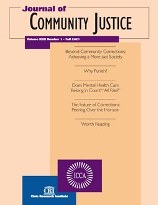Complete Issue
Author: Donald G. Evans.
Source: Volume 20, Number 04, Summer 2011 , pp.1-20(20)

< previous article |return to table of contents
Abstract:
This issue focuses on the siting, support of, and benefits of community-based correctional services such as halfway houses and day reporting centers. The first article, ICCA’s policy position on siting community corrections facilities, outlines a set of principles and makes recommendations that should improve the chances of getting communities to make positive decisions about accepting community corrections facilities in their neighborhoods. The policy notes that in many communities, it is difficult for public and private agencies to secure agreement from local governments and community groups to open community corrections facilities. Controversially, the policy suggests that local jurisdictions should allow the opportunity to site programs in proportion to the number of their citizens who are convicted of crime in that jurisdiction. The second article follows from the ICCA Policy Position and is a report on ICCA’s siting campaign and the development of a toolkit for practitioners. The authors are Kevin Downey, president of ICCA, and Jane Browning, retired executive director of ICCA. The authors discuss the essential nature of community reintegration and community programming. They emphasize the important role of residential facilities in the community corrections continuum. They then turn their attention to overcoming community resistance and fear and to the creation of a siting campaign tool kit that outlines basic steps to assist an agency in reaching out to the community in an effort to gain and maintain support for the establishment of a community facility. The next two articles center on a revival in the use of Day Reporting Centers. Given the issues involved in siting new facilities in the community to help manage offenders’ reentry, there has developed an alternative that meets the needs of a number of returning offenders—day reporting or transition centers that are nonresidential. The general approach of this alternative is to provide evidence-based programs and services to assist the offender in meeting his/her need for housing, substance abuse treatment, and employment readiness and job search. There are a variety of approaches using the general concept of day reporting. The actual labeling of this approach may not be accurate, in that the service provided is far more than mere reporting or monitoring. Successful programs are offering a variety of services that range all the way from individual counseling and advocacy to referral to auxiliary services in the community. The next two articles address issues related to such day reporting centers. Matt Moore, Western Regional Reentry and Supervision Services Manager for BI Incorporated, suggests ways in which smaller programs can be as effective as larger ones and can secure program funding. He advocates that a typical reentry program has a critical mass but that a client-centered one-on-one model can obtain many of the benefits that are achieved by larger programs. Moore makes the case that scalable reentry programs offer opportunities for released offenders. Morry Ulrich and Jordan Sgouraditis, case mangers with the St. Leonard’s Society of Toronto Crossroads Day Reporting Centre, provide us with some preliminary findings of the CDRC need-focused program. They give us a brief overview of the genesis and operation of the program, a summary of the program components, a description of the development of a community-based network of support services, and an overview of the program’s progress to date. From these articles, we get a clearer picture of the issues and challenges facing both offenders and the supervising agencies as they seek to reduce and eventually defeat recidivism for the individuals under supervision. We need to continue to learn all that we can about assessment and change management, to understand more clearly what an offender requires for successful reentry, and maybe to be less dogmatic about our special programs and more open to examining what is in the best interests of the victim, offender, and the community. Finally, Russ Immarigeon’s Worth Reading column in this issue of JCC brings us reviews of the some of the latest studies and commentary in our field. He reviews four books, two of which cover work with female offenders, a neglected area in corrections. Russ’s review of Working With Women Offenders in the Community suggests that this book would make an excellent addition to our professional development library, and his discussion of Female Offenders and Risk Assessment points out the still-prevalent gaps in our development of gender-responsive interventions.Keywords: Siting Community Corrections Facilities; Day Reporting Centers; Need-Focused Programs
Affiliations:
1: Journal Editor.